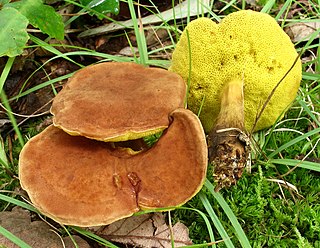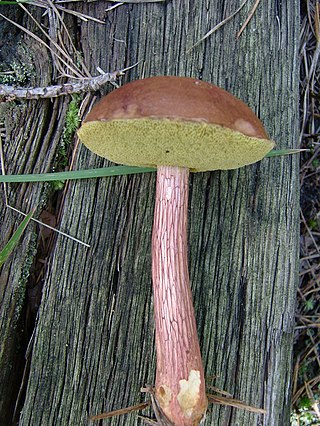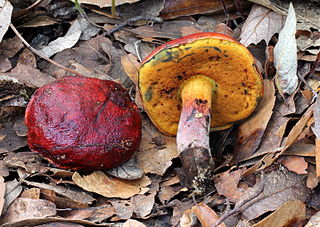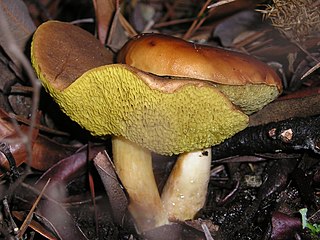
The Boletaceae are a family of mushroom-forming fungi, primarily characterised by small pores on the spore-bearing hymenial surface, instead of gills as are found in most agarics. Nearly as widely distributed as the agarics, the family is renowned for hosting some prime edible species highly sought after by mushroom hunters worldwide, such as the cep or king bolete . A number of rare or threatened species are also present in the family, that have become the focus of increasing conservation concerns. As a whole, the typical members of the family are commonly known as boletes.

Baorangia bicolor, also known as the two-colored bolete or red and yellow bolete after its two-tone coloring scheme of red and yellow, is an edible fungus in the genus Baorangia. It inhabits most of eastern North America, primarily east of the Rocky Mountains and in season during the summer and fall months but can be found across the globe in China and Nepal. Its fruit body, the mushroom, is classed as medium or large in size, which helps distinguish it from the many similar appearing species that have a smaller stature. A deep blue/indigo bruising of the pore surface and a less dramatic bruising coloration change in the stem over a period of several minutes are identifying characteristics that distinguish it from the similar poisonous species Boletus sensibilis. There are two variations of this species, variety borealis and variety subreticulatus, and several other similar species of fungi are not poisonous.

Austroboletus is a genus of fungi in the family Boletaceae. The widely distributed genus contains species that form mycorrhizal relationships with plants.

Butyriboletus regius, commonly known as the royal bolete or red-capped butter bolete, is a basidiomycete fungus of the genus Boletus found in China and Europe. B. regius has a pink cap, yellow flesh, and a reticulate pattern on the stem. Harry D. Thiers described a similar mushroom from California as B. regius, though it is not the same species. B. regius in Europe does not stain when exposed to air, or stains weakly, but the California species stains blue. Both European and California species are considered choice edibles.

Aureoboletus innixus is a species of bolete fungus in the family Boletaceae. Found in eastern North America, it was first described scientifically by Charles Christopher Frost in 1874, from collections made in New England. An edible mushroom, the convex cap grows to 3–8 cm (1.2–3.1 in) wide and is dull reddish brown to yellow brown. The stem is 3–6 cm (1.2–2.4 in) long by 1–1.6 cm (0.4–0.6 in) thick, but often swollen at the apex with a tapered base. It has a bright yellow pore surface when young that dulls in color when mature. There are about 1 to 3 pores per mm when young, but they expand as they mature to about 2 mm wide. The spore print is olive-brown, and the spores are ellipsoid, smooth, and measure 8–11 by 3–5 um.

Boletus abruptibulbus is a species of bolete mushroom in the family Boletaceae. Described as new to science in 2009, it is found only in the Gulf Coast of the Florida Panhandle, where it grows on the ground in coastal sand dunes, one of only three North American boletes known to favor this habitat. The fruit bodies have convex brownish caps up to 8 cm (3.1 in) in diameter, supported by solid yellowish to reddish stems measuring 3–5 cm (1.2–2.0 in) long by 10–15 mm (0.4–0.6 in) thick. The pores on the underside of the cap measure about 1–2 mm in diameter and are initially pale yellow before developing a greenish tinge in age. The mushroom's spores, about 20 micrometers long, are unusually long for a member of the Boletaceae. The stem base is bulbous, a diagnostic feature for which the species is named.

Phylloporus arenicola is a species of bolete mushroom in the family Boletaceae. It is found in the Pacific Northwest region of western North America, where it grows in sand dunes in a mycorrhizal association with pine trees. It is one of only three North American Boletaceae species that occur in coastal sand dunes.

Aureoboletus auriflammeus, commonly known as the flaming gold bolete, is a species of bolete fungus in the family Boletaceae. Described as new to science in 1872, it is found in eastern North America, where it grows in a mycorrhizal association with oaks. The caps of the fruit bodies are golden orange, with a yellow pore surface on the underside, and a reticulated (network-like) stem. The edibility of the mushroom is not known.

Neoboletus pseudosulphureus is a species of bolete fungus in the family Boletaceae. It is found in Europe, Central America, North America, and India, where it grows in deciduous and mixed forests. Initially uniformly yellow in color, all external surfaces of the fruit body undergo a variety of discolorations as it matures.

Xerocomus illudens is a species of bolete fungus in the family Boletaceae. Described as new to science in 1898, it is found in Asia and North America, where it grows in a mycorrhizal association with oak.

Boletus carminiporus is a species of bolete fungus in the family Boletaceae. Described as new to science in 1998, the species is found in the southern United States where it grows in a mycorrhizal association with various trees in mixed forests.

Boletus miniato-olivaceus is a species of bolete fungus in the family Boletaceae. Described as new to science in 1874, it is found in eastern North America and northeast Mexico.

Aureoboletus projectellus is a species of bolete fungus in the family Boletaceae. Found in North America, and recently in Europe, it grows in a mycorrhizal association with pine trees.

Rubroboletus dupainii, commonly known as Dupain's bolete, is a bolete fungus of the genus Rubroboletus. It is native to Europe, where it is threatened, and red listed in six countries. It also occurs in North America, although it is rare there. It was first recorded from North Carolina, and then from Iowa in 2009. It was reported from Belize in 2007, growing under Quercus peduncularis and other oaks.
Butyriboletus peckii is a fungus of the genus Butyriboletus native to eastern North America. It was first described by Charles Christopher Frost in 1878. Until 2014, it was known as Boletus peckii. Recent changes in the phylogenetic framework of the Boletaceae prompted the transfer of this species, along with several other related boletes, including Caloboletus calopus, to the genus Caloboletus. In 2015, Kuan Zhao and colleagues published analysis that demonstrated that the bolete belongs to Butyriboletus, closely related to Butyriboletus pulchriceps.

Butyriboletus pulchriceps is a fungus of the family Boletaceae native to North America. It was first formally described in 2000, as a member of the genus Boletus, and transferred to Butyriboletus in 2015.

Boletus subluridellus is a species of bolete fungus in the family Boletaceae. Described as new to science in 1971 by American mycologists, the bolete is found in the eastern United States and Canada. It grows on the ground in coniferous and mixed forests in a mycorrhizal association with deciduous trees, especially oak. The fruit bodies (mushrooms) have orangish-red, broadly convex caps that are up to 10 cm (3.9 in) in diameter, with small, dark reddish pores on the underside. The pale yellow stipe measures 4–9 cm (1.6–3.5 in) long by 1.5–2.3 cm (0.6–0.9 in) thick. All parts of the fruit body will quickly stain blue when injured or touched.

Boletus amyloideus is a rare species of bolete fungus in the family Boletaceae. It was described as new to science in 1975 by mycologist Harry D. Thiers, from collections made in California. It fruit bodies have a convex to somewhat flattened reddish-brown cap measuring 3–6 cm (1.2–2.4 in) in diameter. The pore surface on the cap underside is bright yellow, with small angular pores and tubes measuring 4–8 mm long. The spore print is olive-brown; basidiospores are smooth, amyloid, spindle shaped to ellipsoid, and have dimensions of 13–16 by 4.5–5.5 µm. The bolete is known only from coastal California, where it grows on the ground in mixed forests. Its edibility is unknown.

Boletus nobilissimus is an edible basidiomycete mushroom, of the genus Boletus in the family Boletaceae. Long considered a variety of European Boletus edulis, it has become a species on its own in 2000, with 2010 molecular study finding that it is most closely related to B. atkinsonii, B. quercophilus of Costa Rica and then B. barrowsii of western United States. It is found in abundance in open oak forests after heavy rains and warm weather.


















